NDVI stands for "Normalized Difference Vegetation Index". NRG stands for "Near-infrared / Red / Green". NDVI and NRG are both ways to visualize the amounts of infrared and other wavelengths of light reflected from vegetation. Because both these methods compare ratios of blue and red light absorbed versus green and IR light reflected, they can be used to evaluate the health of vegetation. It's a snapshot of how much photosynthesis is happening. This is helpful in assessing vegetative health or stress. (Read more here: https://www.agronomy.org/publications/jeq/articles/36/3/832) ## Do-It-Yourself These techniques for vegetation analysis were developed for satellite imagery, but at Public Lab, we've been working a lot on capturing infrared imagery using our DIY [near-infrared camera](/wiki/near-infrared-camera) setup, and combining it with visible bands to produce NDVI images such as the one above. ## What these images mean What exactly are these images we're trying to make? What do they tell us about vegetation, and why? These diagrams should help to understand what it is we're doing and why these are good ways to analyze plant life. ## The NDVI equation [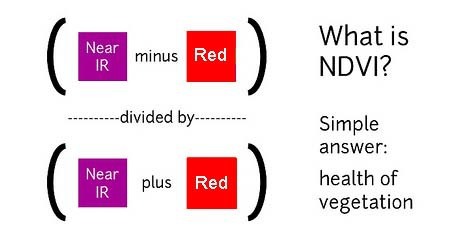](/i/44723) **NDVI = (Near Infrared - Red)/(Near Infrared + Red)** NDVI is a ratio which tries to emphasize photosynthesis while filtering out sun glare. The above equation is run for every pixel, using source data from an infrared photo and a visible light photo, like this pair: [](https://publiclab.org/system/images/photos/000/021/771/original/5390895115_c9d4d38fec_o.jpg) The result can be false-colored to make the high-photosynthesis areas more clear, and used to examine where plants are and how healthy they are. [](https://publiclab.org/system/images/photos/000/021/770/original/PetVISNDVIcomp.png) _Figure above: Normal color photo (right) and normalized difference vegetation index (NDVI) image (left). NDVI image was derived from two color channels in a single photo taken with a camera modified with a special infrared filter. Note that tree trunks, brown grass, and rocks have very low NDVI values because they are not photosynthetic. Healthy plants typically have NDVI values between 0.1 and 0.9. -- @cfastie_ ### Activities Here are a range of activities you can do to produce and interpret your own NDVI imagery, whether downloaded from a satellite imagery provider or [collected yourself using a DIY technique](/wiki/multispectral-imaging) [activities:ndvi] ****   Most DIY converted cameras today (those from Public Lab) use RGN instead of NRG, so the blue channel represents infrared instead of the red channel. That looks like this: [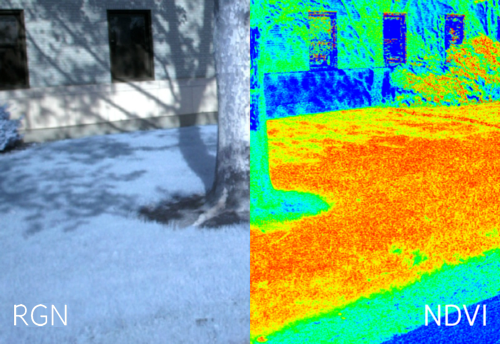](/i/45468?s=o) **** ## NRG imagery Some people are also interested in producing NRG imagery (like the below image), where `Near-Infrared, Red, and Green` are used to compose a picture instead of the usual `Red, Green, and Blue`. [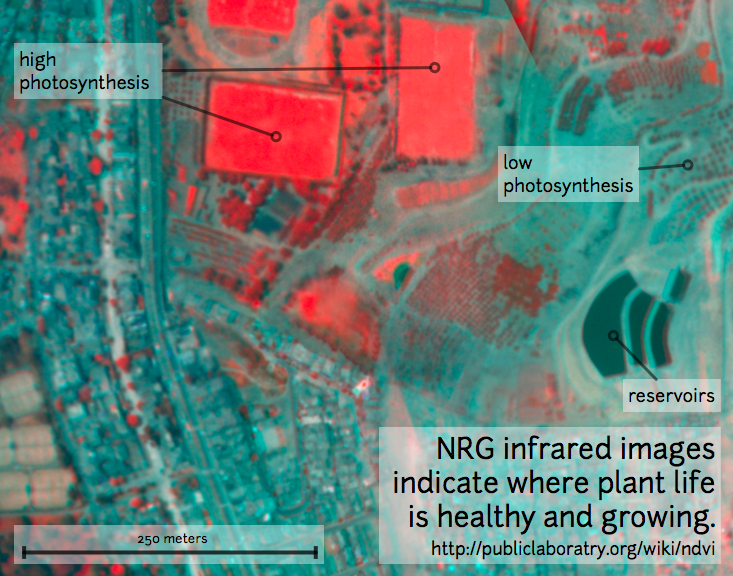](/i/25064) This diagram explains the swapping, which allows us to 'see' infrared as if it were a normal color: [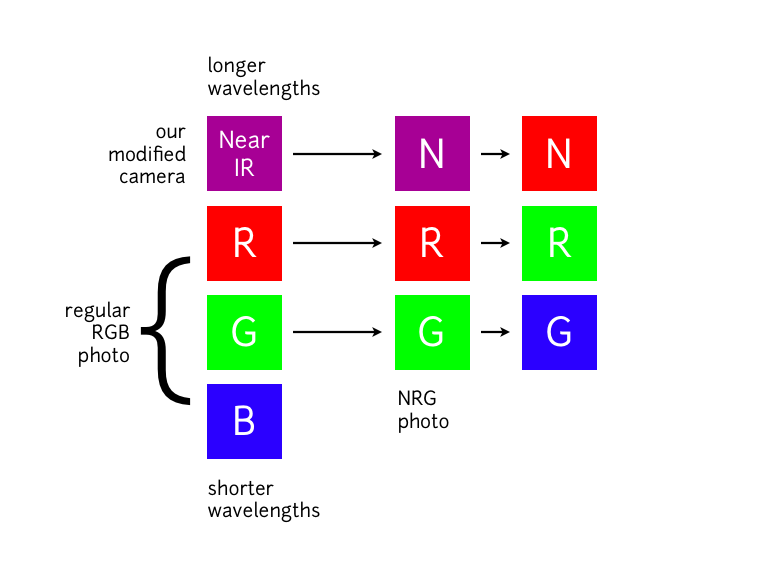](/i/25063) **In NRG images, the deeper and clearer the red color, the denser and healthier the vegetation (more or less).** ### Questions [questions:ndvi] ### Other examples of DIY NDVI imaging From around the internet: Begin watching at 2 minutes to see the resulting imagery: *This topic is part of the [Grassroots Mapping Curriculum](/wiki/mapping-curriculum) series.* **** [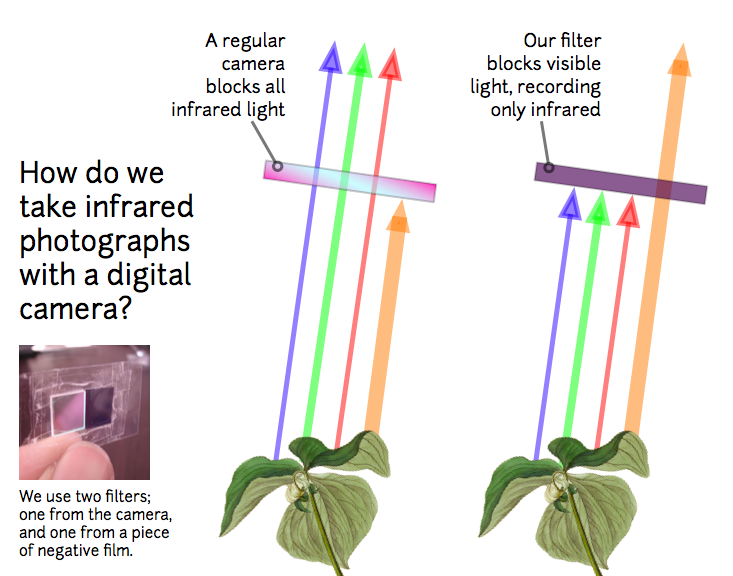](/i/25066) [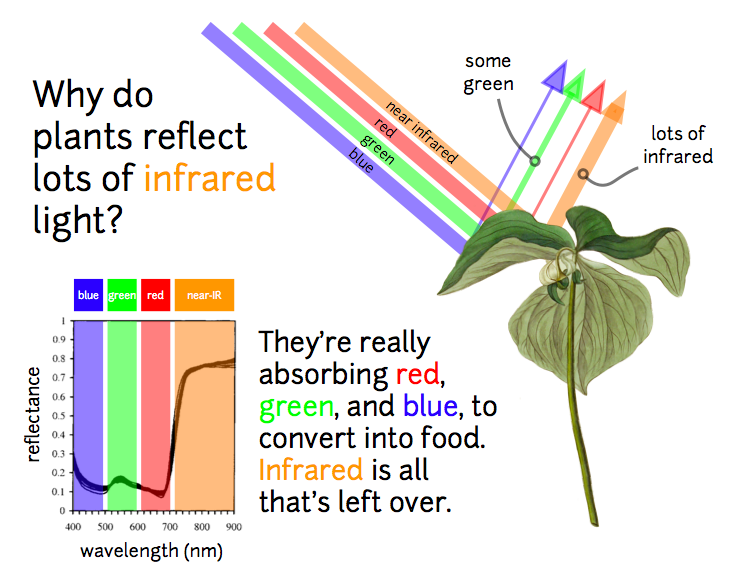](/i/25065) ...
| Author | Comment | Last activity | Moderation | ||
|---|---|---|---|---|---|
| cfastie | "Public Lab promoted dual-camera IR systems more than three years ago before they found that the one camera systems worked well enough to get people..." | Read more » | over 10 years ago | |||
| patcoyle | "Very nice results! " | Read more » | over 10 years ago | |||
| fliperbaker | "Hi Chris, your supposition is right, my white balance was done at direct sunlinght, I tried today balancing in the shadow and the new images appear..." | Read more » | over 10 years ago | |||
| cfastie | "This is a great analysis. I like your interpretation of the filter spectral graphs. Rosco confirms that 2007 passes more light (10% transmission) c..." | Read more » | over 10 years ago | |||
| cfastie | "GIS programs are really good at doing that kind of spatial analysis. If you give them the appropriate information, they can scale and correct the a..." | Read more » | over 10 years ago | |||
| RonGeorge | "Very interesting post. How can one take this a step further and analyze the % green areas that correspond to greenery? For example, the output woul..." | Read more » | over 10 years ago | |||
| cfastie | "I think any camera could allow you to estimate how thick ice is, if you can put the ice between the camera and the light source. The thicker the ic..." | Read more » | over 10 years ago | |||
| kugiel | "with this camera can I see how deep is ice? " | Read more » | over 10 years ago | |||
| lorati | "realy good think " | Read more » | over 10 years ago | |||
| geraldmc | "(from a recovering Yankee fan living in Louisiana) Orioles RULE! Thanks Chris. " | Read more » | over 10 years ago | |||
| eustatic | "hmmm, having trouble making snapshots, but i finally got this to work! these files are so huge.. " | Read more » | over 10 years ago | |||
| jtuhtan | "Hi, I've updated the YouTube link, should work now. Contacted Jeff regarding the implementation in the Infragram.org site to see what he thinks... ..." | Read more » | over 10 years ago | |||
| cfastie | "Jeff, It was the other Jeff (Warren) who must have added the new colormap at infragram.org. I assume some differences snuck in during the manual tr..." | Read more » | over 10 years ago | |||
| jtuhtan | "I've checked the javascript from the Infragram.org site and could not see any image preprocessing from what was there, the NDVI index was calculate..." | Read more » | over 10 years ago | |||
| theowallis | "Thanks for your reply Chris! " | Read more » | over 10 years ago | |||
| jtuhtan | "The Fastie colormap was already implemented in infragram.org, so I can't take any credit there! What I am wondering is why there seems to be a shi..." | Read more » | over 10 years ago | |||
| cfastie | "Wow, I didn't know there was a Fastie colormap at Infragram.org. I think it will need a new name (How about VGYR for violet green yellow red?). I g..." | Read more » | over 10 years ago | |||
| cfastie | "Theo, I have gotten that error too, even when using my own pairs of simultaneous photos (I think the cameras' clocks were way off). I forget what I..." | Read more » | over 10 years ago | |||
| unsignedint | "Hello liz, I think B&W+Green reveals the presence of IR very clearly. The problem is that the intensity is hard to tell, so other color schemes..." | Read more » | over 10 years ago | |||
| theowallis | "Hi I am trying to process two images in Fiji, one raw infrared, one visible spectrum. When choosing the two image files from which to create a tex..." | Read more » | over 10 years ago | |||
| cfastie | "I don’t quite understand how this subtraction would work. When using a red filter, we expect the blue channel to record mostly near infrared light ..." | Read more » | over 10 years ago | |||
| liz | "This B&W and green image is so striking! " | Read more » | over 10 years ago | |||
| jtuhtan | "Great colormap! I am using MATLAB to calculate and create images based on the Infragram Point and Shoot (modified Mobius). When I compare my images..." | Read more » | over 10 years ago | |||
| nedhorning | "Hi Alan, That sounds good. The first thing your son will realize is that I'm not a very talented programmer. I'm traveling until early next week b..." | Read more » | over 10 years ago |